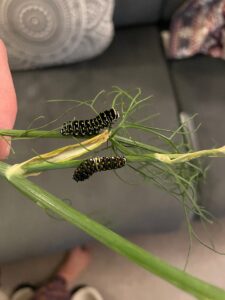 Fall writings and depictions often don’t include butterfly images, but these clever creatures of nature are on my mind year ‘round. They’re viewed as a symbol of transformation and hope. They can see colors we can’t because they perceive ultraviolet light. And no matter what time of year, is there anything sweeter than a child or a loved one giving you a butterfly kiss?
Fall writings and depictions often don’t include butterfly images, but these clever creatures of nature are on my mind year ‘round. They’re viewed as a symbol of transformation and hope. They can see colors we can’t because they perceive ultraviolet light. And no matter what time of year, is there anything sweeter than a child or a loved one giving you a butterfly kiss?
A couple of weeks ago my sister sent me an email with two caterpillars on a stem she had picked from her garden. She asked, “Any idea what these are? Just found them on the fennel I brought in yesterday from my garden.” At first I thought, “Whoa. These guys are going to get cold!” But then I keyed them out and discovered these were black swallowtail butterfly caterpillars. This species of butterfly will hibernate as a mature caterpillar, or it may shed its last skin and emerge as a pupa (chrysalis). After this stage, they will enter diapause, (big word), a period of suspended development until spring.
There are many cool things to learn about butterflies. The average life span of a butterfly is 2-4 weeks. Think about how tenacious this being is to go from egg, larva, pupa, and then to become a fully functioning, nectaring and pollinating adult in that little bit of time. If I get my recycling out every 2-4 weeks I’m happy.
Back to my sister’s caterpillars, she found them on fennel, which makes sense because it’s their host plant. They love the aromatic blooms and lay their eggs on the leaves. These caterpillars can also be found on dill, a cousin to fennel.
Earlier this fall we held a fundraiser on our trails which included craft beer samplings. We had some trivia cards to pair with the tastings. One of the questions asked, “What butterfly depends on hops as its host plant?” The answer: the eastern comma butterfly. For a beer themed event, that’s fun to know. However, the eastern comma is fascinating in so many other ways. (By the way, it gets its name because when its wings are folded, you can see a little white “comma” or letter C on the hindwing.) These butterflies overwinter in rock crevices, tree cavities, under bark or in other protected areas. Now get this, their blood contains glycerol, which acts as an antifreeze, so their tissues avoid cell damage during winter freezes. These winged rock stars have even been reported as pursuing dragonflies and birds! Now that’s cool!
And our beloved monarch, we just can’t talk about butterflies without mentioning monarchs. The last ones to go, migrating actually, have already headed out to Mexico. When possible, we safely capture and tag them before they migrate. A tiny sticker with a special code relating back to Woodland Dunes is placed on their wing. In the past, we’ve received a certificate from the Monarch Watch program stating that they have discovered one of “our” monarchs in Mexico. What a neat feeling to know that your ‘baby’ safely made it all the way to its wintering ground.
Our planet is filled with such neat creatures and experiences. Our lives are touched by them all. As we continue to work to protect them, there’s a sweet reward of a butterfly kiss waiting for us all.
Photo by Katherine McMahon
